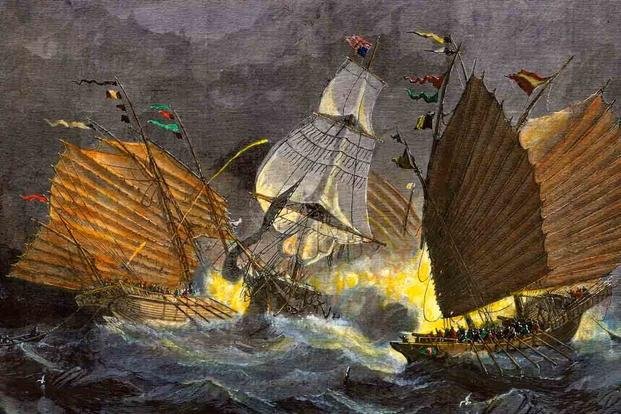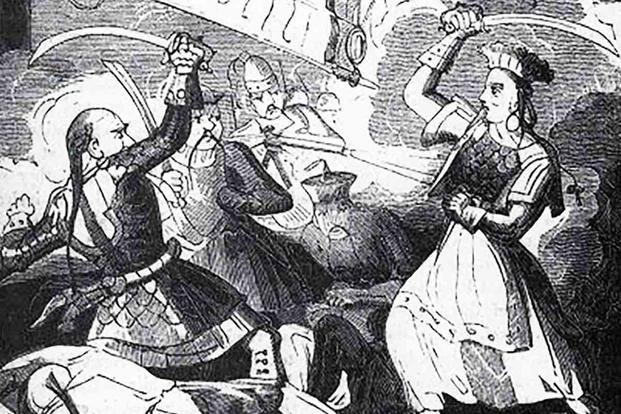In 1808, the Chinese Qing government, overwhelmed by pirates in the South China Sea, decided the time had come to take out the worst of them all. The Red Flag Fleet, under the command of the notorious pirate Ching Shih, had been a continual thorn in the side of commerce for years. The Qing gathered a massive fleet of warships and set a trap for them.
Rather than hightail it for a safe harbor in the face of an enemy that outnumbered her, Ching Shih sailed right for the government forces. When the smoke cleared, the Red Flag Fleet left behind a graveyard of burning hulks, roughly half of the Qing Navy, and even took a few dozen ships home with them.
When confronted with a massive fleet of ships bent on destruction, standard operating procedure for pirates in the Caribbean and elsewhere would have been to tuck tail and run until the heat is off. Or maybe they'd wait until some European colonizer needed their ships elsewhere, leaving the pirates free to raid the seas once more. Except Ching Shih was anything but your standard pirate.
For starters, she was a woman, a former sex worker who married into the pirate life but turned out to be really, really good at piracy. While Caribbean pirates like Blackbeard could boast a handful of ships and hundreds of men (at best), Ching Shih commanded an entire armada, with more sailors than most nations could muster, so she was also not afraid of the Imperial Navy.

There's a reason she would be remembered as the most fearsome pirate in history.
Stanford historian Dian H. Murray wrote about Ching Shih in her book, "Pirates of the South China Coast, 1790-1810." For nearly a decade, Ching Shih either shared power or outright controlled the South China Sea, no matter what the Qing emperor thought. At the height of her power, she commanded 400 ships with an estimated 40,000 to 80,000 men and was capable of taking on any maritime force in the region.
Before she ruled as Pirate queen, she had a much more humble life. At a time when the U.S. Navy was barely a thought, Ching Shih was born as Shi Yang into a Tanka family, a people who lived and worked on junks (a kind of Chinese sailing ship) along the coast of China. As a young woman, she worked in the brothels, gambling houses and boats of Guangdong.
Her life changed drastically at age 26, when she married the notorious pirate Zheng Yi in 1801. Her new husband's pirate fleet was already impressive, but it became an armada under her shared command. For about a year after being wed, life carried on as normal as it could for a husband-and-wife team of pirates. That all changed in 1802, when Zheng's cousin, a pirate in his own right, was killed by the Vietnamese.
Zheng had to consolidate power over his cousin's pirate fleet, but thanks to Shi Yang's business acumen and organizational abilities, the infighting among the pirates was short-lived. She helped negotiate a truce among the leaders of the pirate fleets into one confederation. Six fleets, each flying a colored flag -- red, black, blue, white, yellow and purple -- would essentially operate as a pirate navy.
Together, Zheng and Shi commanded the largest fleet, the Red Flag Fleet, and by 1806, every seagoing vessel in the region paid tribute to them for protection. All was well for the couple until Zheng was either killed in a storm or also killed by the Vietnamese. Either way, he was gone, and it was time for his widow to take over.

Now known as Ching Shih, she married Zheng's adopted son, Cheung Po Tsai, who was supposed to inherit his father's command. With this marriage, she took control of the Red Flag Fleet. Her first act was to implement a code of conduct that ensured discipline among the outlaws, effectiveness in combat and, above all, success and riches from loot. Here's the rundown:
• Only Ching Shih could authorize an attack. Unsanctioned attacks were punished by beheadings.
• Loot is to be gathered by superiors and distributed equally. Punishment for the first infraction was a severe beating. Repeat offenders were beheaded.
• Ears were cut off those who deserted their post. The second time they deserted, they were beheaded.
• Rape was punished by beheading.
• Consensual sex without Ching Shih's permission meant a beheading. Your female partner slept with the fishes.
• Pirates had to marry female prisoners before they could be ravaged. Cheating on your new spouse or treating her poorly was punished by beheadings.
On top of earning protection money from shipping, Ching Shih raided coastal villages and kidnapped foreign officials for ransom. It's actually because of one of those hostages, a Richard Glasspoole who was held for four months, that we know much of anything about her operation.
The Qing Dynasty did what it could to deter or defeat her. The pirates defeated a 35-ship flotilla under the command of Lin Guoliang off the coast of Shenzhen. Another government force under Sun Quanmou attacked with 100 ships, only to be sent packing. After the naval spanking of 1808, they asked foreign navies for help.
None truly defeated her or the pirate fleet she gathered. At the September 1809 Battle of the Tiger's Mouth, the Red Flag Fleet faced down a joint Chinese-Portuguese battle fleet that tried to bottle her up in Tung Chung Bay. For three months, the blockading Portuguese attempted to destroy her ships. She took some pretty heavy losses, but sailed away with her pirate force largely intact in the end.

Ching Shih realized the government harassment would never end. She used her considerable power to negotiate a pardon for herself and her sailors when her enemies were at their weakest; she negotiated a cash settlement, a title of nobility and was even allowed to keep a small flotilla of ships and sailors.
A life that began in poverty ended in fame and prosperity. She died at age 69 as the owner of her own gambling house, widely respected and remembered for her extrajudicial exploits on the South China Sea.
-- Blake Stilwell can be reached at blake.stilwell@military.com. He can also be found on Twitter @blakestilwell or on LinkedIn.
Want to Learn More About Military Life?
Whether you're thinking of joining the military, looking for post-military careers or keeping up with military life and benefits, Military.com has you covered. Subscribe to Military.com to have military news, updates and resources delivered directly to your inbox.
















